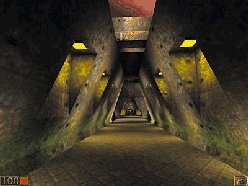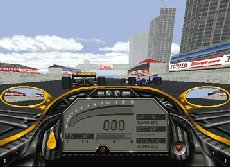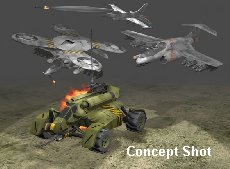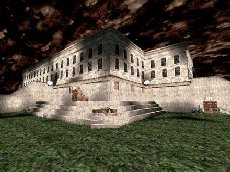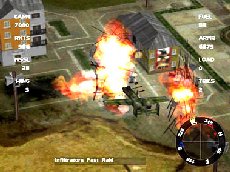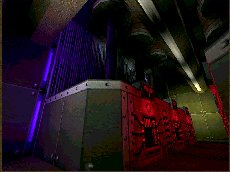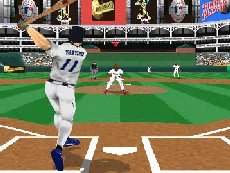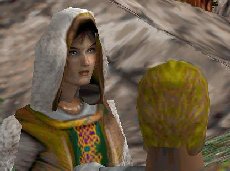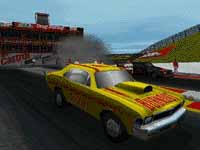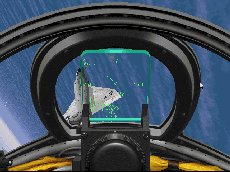
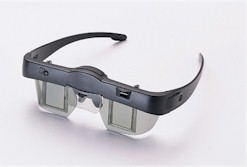
Unofficial
H3D/Wicked3D
Eyewear Page
initial release of this page:
January 1998
last update: December 28,
1998

Quick info: The
H3D
Eyewear is a wireless 3D-shutterglasses system for the PC. It utilizes
a VGA-pass-through controller. The controller contains a "sync-doubler"
and a "line-blanker", which achieve compatibility
to any graphics hardware, even the latest 3D-accelerators. This is a unique
set of features in the consumer market today. The H3D glasses are the only
consumer solution for 3Dfx Voodoo 1 & 2 add-on boards so far.
In conjunction with the Wicked3D driver
technology the H3D glasses offer support for almost all 3D-accelerated
Windows 95/98 games. An image viewer - Brightland H3D View - is available
as shareware. The H3D-Activator freeware makes the glasses work with some
non-H3D 3D-software on a true color Windows desktop.
By the end of November
98 H3D went out of business, because of financial problems. At the moment
it looks like the product will survive under the Wicked3D label.
NEW: H3D-Activator
Now that H3D as a company is gone the underground
tools and hacks are coming forward. There's now a little program called
H3D-Activator which.... well you guessed it. H3D fought such tools until
the end. They prefered to stay proprietary. The tool is available at stereovision.net
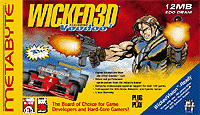
|
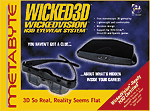
|
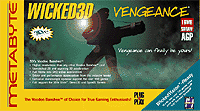
|
metabyte Voodoo 2 board
|
H3D in metabyte packaging
|
metabyte 3Dfx Banshee board
|
Graphics hardware manufacturer Metabyte
offers some unique 3Dfx Voodoo2 and Banshee boards, under the Wicked3D
label. They feature driver level stereoscopic support for H3D. In theory
any
Direct3D, miniOpenGL or 3Dfx Glide software - mainly games - can be
watched in true 3D. This is not fake-3D, it's real, because the driver
has access to the 3D-data, i.e. to the depth-information. Since standard
software isn't designed for stereo3D there are problems with on-screen
text and other 2D elements. In some cases there are other 3D-math related
slipups. However there is no better stereo3D gaming solution than Wicked3D
plus H3D currently on the market. The Wicked3D drivers do not work for
other brands of 3Dfx boards, they are protected.
Beside the H3D glasses some other "sync-doubler"
shutterglasses can be used in conjunction with the Wicked3D hardware, but
such glasses are usually far more expensive, since they are targeted on
the pro-market.
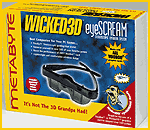
metabyte eyeSCREAM
H3D and the Wicked3D drivers targeted
on all Voodoo2 board owners
The new Wicked3D
Eyescream brings universal H3D support to all brands of Voodoo2 boards
and later to all Banshee boards too! Possibly there will be a driver-CD-only
package also.
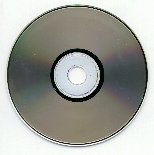
metabyte stand-alone Wicked3D driver
CD for 3rd party Voodoo2 boards
For all users who already own the H3D glasses
and a non-Wicked Voodoo2 board metabyte now offers a CD with the drivers
for $29. If you don't buy it immediately you must be crazy (or a software
pirate).



December 98: H3D Activator released, metabyte
Wicked3D eyeSCREAM released, metabyte Wicked3D stand-alone driver CD released.
November 7, 1998: The Brightland
H3DView Image Viewer has been finally
released. It was about time! Look at the July 98 news below!
August 21:How
to run all stereo capable windows desktop programs using H3D!I
just found out that Classy Glasses got the permission from H3D
to distribute the unofficial/unsupported H3D-Win-Quake beta. Get it there!
I was sitting on this beta-file for month and had orders from H3D not even
to talk about it - oh well. Now what is it good for? Basically it allows
Quake1 to run unaccelerated in a Window on the Desktop. In other words
it's pretty useless from the Q-Point-of-View.
The BIG THING is that while Q is running in
a window the whole desktop is set into line-blanking mode. So if you
got enough RAM, just start H3D-Win-Q and minimize the window. Now you can
run your web-browser or image viewer and watch stereo images from the web.
You can also use programs like the 3DEM landscape generator freeware or
whatever you like. Set the right stereo orientation by software-switch
or by moving the image. - Have fun. (Please note: I haven't tried the H3D-Win-Q
version from Glassy Glasses yet. I just assume it's identical or at least
behaves like the version I got.)
The best thing would be if H3D released an utility
to control the H3D system manually under DOS and Win, but they don't want
that. H3D could even handle all the professional stuff for CrystalEyes
and the like. H3D has the mightiest controller in the world. It can do
more than ANY other controller whether consumer or professional, but -
and I can't stress this enough - they kind of maimed it! I just can't get
over this. The line-code is a nice thing for comfort as long as it's there,
but if it's not there the system is dead. I think the code is a very good
idea, the only thing I ask for is a manual override. - Uhhh, yes and bigger
panels of course.
July 1998: Brightland
is about to release a H3D Image Viewer.
It was about time!
July 1998: H3D users will have to learn
some new vocabulary. It's now all about application-level vs. driver-level
H3D-support. Please check the Wicked3D
homepage and the Wicked3D-FAQ on the H3D
site.
May 26, 1998: I was asked if it would be
possible to build an alternate H3D-transmitter to make H3D glasses
compatible to non-H3D software. Well, I don't see the point for a new IR-transmitter,
but what about a new controller? Based on the circuits for homebrew
controllers (ser, par, VGA, sync-doubler) one could build a controller
with a mini-DIN-3 connector for the H3D-IR-transmitter, instead or in addition
to the usual connectors for wired-glasses. I think this device wouldn't
require the H3D-line-code and could work on LCD-BIOS, etc. The problem?
I don't know the signaling of the H3D miniDIN-3 connector. H3D told
me it's different from the VESA3 miniDIN-3 signaling. (Thanks to Nik http://surf.to/eastfield
for asking.)
April 24, 1998: As you might know from
the official H3D-News page there's
an interview with the H3D-staff in RealVideo on GameTime.
Since the interview is rather long (1 hour) here's a summary of what I
found new & interesting:
- The H3D controller actually amplifies the VGA-signal
to prevent signal-losses. That's the reason the signal goes away when the
dongle isn't powered. (True?)
- H3D doesn't seem to be interested in an API
or a 3D-engine which gives developers stereo-support by default on their
own. They want to actively participate in every single software project
for quality-assurance.
- Voodoo 2 support is the No.1 on H3D's To-Do-list,
so it's just a matter of time until it's done. Reportedly they had to wait
for a stable V2-code base to do their magic on it.
- Voodoo 2 SLI mode (two boards) with 1024x768
Z-buffered will be supported.
- 1024x768 is the max. resolution the H3D-controller
can handle.
- The 3D-accellerator chipsets, H3D concentrates
on, are 3Dfx and Rendition, with NVidia next on the list!
- H3D is developing new versions and add-ons
to the glasses: different designs, different colors, alternate nose-pieces,
frames and most important: larger LCD-panels!!!
- With the curent know-how provided by H3D a
software developer should be able to incorporate H3D support into his product
within 3 to 4 days! The development of H3D-Quake1 took 5 month, but this
was a R&D project.
- Unreal (Epic Megagames): H3D can't announce
this officially yet, but they're very interested in this title and are
in close contact to the developers.
- Forsaken (Acclaim): H3D is interested in this
title too. They talked to the developers, but it's unclear if this game
will be ported.
- H3D talked to tons of software developers including
Activision, GTInteractive and Epic.
- H3D tries to get support in MS DirectX.
- H3D is mainly interested in A-class titles.
- Retail distribution: H3D will start retail
distribution when there's a basis of about 20 to 25 A-class software titles
available.
- 3D-sound may be incorporated into the eyewear
in the future.
- Big announcements by H3D to follow in the near
future!
The Controller/IR-Transmitter
|
The H3D-system comes with two black boxes. One connects between
VGA-out and monitor and contains the controller and sync-doubler circuits.
For a VGA-dongle it's quite large and heavy and puts some pressure on the
jack of your VGA-card when used in the gravitational field of a larger
planet. The second box contains the infrared transmitter.
The cable of the transmitter is long enough to reach up to the top of the
monitor, even when used on systems placed under the desk. The whole system
has only one button. It switches the IR transmitter between near and far.
The default setting is far, but if there are more than one H3D transmitters
in the room (for network gaming) near-setting might prevent interference.
The transmitter is activated by a colored pattern on top of screen,
which is provided by H3D-certified software. No drivers software is required
whatsoever.
The controller/transmitter has to be powered all the time or
it won't pass-through the normal VGA-signal.
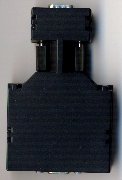
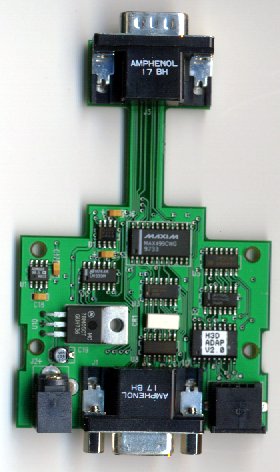
Black Box 1: The miraculous v-sync, sync-doubler, line blanker
VGA-pass-through controller of the H3D Eyewear system in the NUDE (eehhhk).
From left to right: power in/VGA-out/IR-transmitter-out (miniDIN-3).
Photo by Christoph (what a pervert).
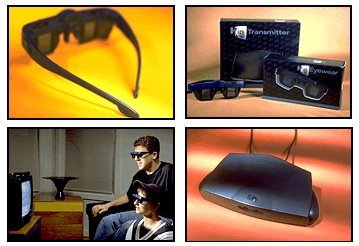
Black Box 2: The IR-transmitter
IR-Transmitter cable length
VRSurfer
|
120 cm
|
H3D Eyewear
|
200 cm - Ahhh, I needed that!
|
BTW, the H3D glasses doesn't listen to the IR signal from the VRSurfer
transmitter and vice versa. I expected this, but it would have been really
cool to use them together.
UPDATED: Power
supply (220Volt users listen up!)
The current H3D transmitter comes with a US-style 120V to 9V power adaptor.
Usually this is of no concern, because other power adaptors can be used.
Not in this case!!! The H3D hardware is very tricky when it comes to the
voltage.
Use a good, adjustable, stabilized (a bit more expensive than un-stabilized)
universal power adaptor. (Available in electronics stores for about $15
upwards.)
The H3D controller has a small power plug (like modems and walkmans)
and the following specification: 9V DC 200mA.
My adaptor is set to 6V however.
In case the the power isn't right the H3D-dongle doesn't pass-through
the VGA signal and the monitor remains black!
If the power is slightly out of range the VGA-signal goes through,
but is distorted.
That's why I'm recommending a power supply which is adjustable in small
steps.
H3D now offers a 220V power supply for 10 extra
bucks. Don't hesitate to get it if you're located in a 220-country. The
H3D-dongle is quite delicate when it comes to the right voltage. The original
supply is better than an universal adaptor.

Don't miss the rest of this gigantic
3D website!!!

The design of the H3D Eyewear was stolen from the late 21st century.
(Call the time-cops!) The lower part of the glasses is completely
transparent. The glasses are incredibly light, even lighter than
the wired glasses I've tested. They're are a bit small for
my big head, but it's acceptable. Usually comfort should be very
good. I still prefer the 3D-Spex when it comes to comfort though, but that
might be due to my personal off-the-scale physique.
The optical quality of the LCD-panels is good. There are no distortions.
A unique feature is the adjustability of the panels. Each LCD-panel can
be moved to the left and right, to fit the individual eyeball-distance.
That's neccessary, because the panels are rather small and narrow. My 17
inch monitor screen fits barely into the view-field. On the borders of
the field of view the vision is blurred by the transparent frame which
holds the LCDs. The H3D eyewear can be worn over prescribed glasses, but
those shouldn't be wider than 14 cm. The distance between the eyes and
the LCD-panels is increased then, which might limit the field of view even
further. The H3D-glasses itself are 15 cm wide.
The manual says: "If you find the Eyewear uncomfortable for your particular
viewing situation, contact H3D Entertainment, Inc. for more information
about our Eyewear accessories."
The glasses are powered by two small lithium batteries (CR-2032).
They are placed in the middle, which prevents any weight ballance problems.
On one of my two H3D glasses the battery case doesn't close perfectly,
but that shouldn't be of any concern.
The glasses are automatically activated by putting them on.
Due to the light construction and the almost unprotected LCD-panels
the glasses should be treated like raw eggs.
News update: After reading my "raw-egg" statement H3D pointed
out that the eyewear is more damage resistant than the light design might
imply. They were tested under rough conditions and should survive all minor
"accidents". No reason to be rude though.
LCD-panel size (width x height) per eye
H3D (adjustable eye distance!)
|
2 x 2.5 cm (rectangular)
|
VRSurfer
|
3 x 2.8 cm (rectangular)
|
3D-Max
|
4 x 2.3 cm (rectangular, with a little edge missing in the
"nose-region")
|
3D-SPEX
|
3 to 4.7 x 1 to 3 cm (round form)
|
Weight
(measured with my own humble paper-weight)
VRSurfer (wireless)
|
155 g (with battery & headband)
|
VRSurfer (wireless) - hack n' slash
|
125 g (with battery, but w/o foam, front, headband)
|
3D-Max (wired)
|
70 g (w/o cable)
|
3D-Spex (wired)
|
55 g (w/o cable)
|
H3D eyewear (wireless)
|
45 g (with batteries) - congratulations!
|
Battery Life
(according to manufacturers manual)
H3D-Eyewear
|
200 hours
|
VRSurfer
|
1000 hours
|
Check the X-RAY lab for a comparison
between the various glasses.
Hardware (VGA-card) compatibility
|
In short: H3D is
the only consumer system, currently available, which is compatible to ALL
current and future graphics cards.
The H3D hardware looks very good when it comes to graphics hardware
compatibility. Usually shutterglasses require a compatible VGA-chipset
and a driver which provides page-flipping or interlace modes. The H3D-controller
can sync to page-flipping too if available, but that's not neccessary.
H3D
is the first consumer system which incorporates a Sync
Doubler device which transforms a normal screen mode into a kind of
page-flipping. It automatically doubles the vertical frequency (the
refresh rate). The VGA-card hasn't to be set to any special mode.
Example for Sync Doubler modes:
VGA-card-output
|
Monitor output
|
640x480@60Hz
|
640x240@120Hz
|
1024x768@60Hz
|
1024x384@120Hz
|
Since the lowest setting on most VGA-cards is 60Hz your monitor has
to support at least 120 Hz refresh if sync-doubling mode is used.
By setting the screen modes to 75 Hz I reached 150 Hz with the H3D,
even in 1024x768 mode. That's quite good. At 85 Hz the H3D-controller refused
to activate.
The Sync Doubler mode shows fine black "interlace" lines, just like
most modes used for systems like 3D-Max or VRSurfer. As far as
I know the Sync Doubler mode is activated in H3D-DOS-Quake and in H3D-GL-Quake
when used with a Voodoo 1 or 2 Graphics add-on board. The sync doubler
mode shows an up/down split screen in case the H3D-controller isn't installed.
Sometimes the controller misses the control-pattern. In this case turn
off and on the H3D option in the software again. See to it that the two
horizontal beams in the calibration screen are perfectly alligned.
As far as I know on Voodoo Rush and Rendition boards sync doubling
isn't used. The page-flipping is produced by the graphics-boards. The
images are line-doubled, which avoids the black interlace lines and
looks even better. In a non-sync-doubler mode you might have to set
the refresh rate manually by using a utility from the board manufacturer
(or something like Scitech Display Doctor). The initial refresh rate might
be 60 Hz which isn't acceptable. Find out how to increase it on your VGA-card.
The resulting horizontal frequency is higher (2 times) than in sync-doubler
mode. A "hot" monitor is recommended.
NEW 21/01/98 : H3D-controller
does Miracles! You thought the Sync-Doubler
in the H3D-box was a little sensation? Well it was, but what I found out
now will blow you away. The technical novices might not understand this,
but you experts better buckle up! It's unbelievable, yet proven. Yesterday
I would have bet a $$$1000 against it, but it's true. I saw it. I put it
to the test. The H3D-controller can generate
interlace out of thin air. I had to check
back with H3D-engineering because I thought I'm loosing my mind.
VGA card and monitor are in normal non-interlaced/non-page-flipped
mode, no sync doubling involved, resolution & refresh are normal, but
your eyes see interlace. How is this done?
Here you go:
The H3D-controller scans the frame and blanks out the odd lines. In the
next frame the controller blanks out the even lines and so on. The refresh
rate and other parameters aren't changed. The lines are still there, they're
just black now. This is not even page-flipping. It's what I would call
"synthetic interlace", without the participation of VGA-card or monitor.
No software driver is involved. The H3D-box does the job.
In the future this can be used to set the Windows
desktop into this "synthetic-interlace" on any, I said ANY (!!!) VGA-hardware.
That way you can watch interleaved stereo images on the web or use other
interlaced (alternate line) software on your windows desktop (or somewhere
else maybe), without tweaking your graphics hardware (that's what all the
other systems do). The H3D-control pattern is still required to activate
the glasses of course. Software which
activates this mode isn't officially available
yet. Please be patient.
H3D VGA-chipset support
Split Screen
Sync Doubling
|
Line-Doubled Hardware Page-Flipping
(done by the VGA-card,
best image quality)
|
Interleaved Format-
"Synthetic Interlace" or Line-Blanking
(done by the H3D-box)
|
Hardware-Interlace
(done by the VGA-card)
|

|

|

|

|
-
H3D-DOS-Games on all VGA chipsets
-
H3D-GL-Games on Voodoo Graphics 1&2 add-on boards (i.e. Monster and
the like)
|
-
H3D-GL-Games on Voodoo Rush, Rendition and others
-
H3D-V-Games on Rendition chips
-
H3D-Win95-Games on all hardware page-flipping capable VGA-chips (???)
|
-
Used for future windows desktop applications, works on ALL VGA/graphics-chipsets
|
-
AFAIK H3D doesn't seem to plan support for this. It would require chipset
specific drivers. Some newer chipsets doesn't support interlace at all.
|
Thanks to the Sync-Doubler device the H3D goes where no consumer shutterglasses
has gone before (e.g. Voodoo1 & 2 add-on cards support). Unfortunately
to achieve optimum image quality a Voodoo Rush, Rendition or some other
hardware-page-flipping capable chipset is required. In this case the sync-doubler
isn't needed anymore.
The H3D is, as far as I know, the only consumer shutterglasses solution
for Voodoo Graphics 1 or 2 add-on-board users at the moment!
(Voodoo2 support is currently unavailble. It will be added when
Glide 3.0 is released.)
Please consult the Technology page
for more info on these issues.
Software compatibility isn't an issue with the H3D system. There is
no compatibility beyond proprietary software. At the moment only H3D-certified
software will work. There is Quake1, soon there will be GL-Quake2 and some
other game titles, that's it!
You can't use any other applications,
multimedia
titles or games. The H3D eyewear
comes without any drivers or software. There is'nt even an image viewer
to watch stereo-pix from the internet. (Image viewing capability is announced
though.) There are over a hundred software titles listed on my pages. The
H3D systems works on none of them, apart from the few H3D-titles. It's
a shame. Usually I loose my temper if some controller refuses to work
on a few titles. I hope there will be some tool from H3D or from a hacker
which enables the glasses on the windows desktop or even in DOS.
I must admit the list of H3D announcements is quite hot and there's
a good chance they'll become a reality.
From the hardware point of view the H3D-controller could achieve backward
compatibility to almost all other shutterglasses and HMD's, but H3D intensionally
prevented this by the use of a proprietary control system. The irony is
that H3D doesn't work on the software of it's competitors, but there are
a few (very few) competitors which run on H3D's software in some cases,
depending on the VGA-hardware used.
At the moment the H3D system can complement other
shutterglasses systems (like VRSurfer, 3D-Max, 3D-SPEX and others),
but it can't replace them, because of the compatibility issue.
On the other hand most other consumer shutterglasses DO NOT support
the H3D-software at the moment, no matter what VGA-board is used.
So you want to play GL/V-Quake 1&2 NOW?
The easiest way to do this is by using a H3D system !!! You have a Voodoo
1 or 2 add-on (not Rush) board? H3D is a MUST then!!! (Voodoo
2 users will have to wait until Glide 3.0 for H3D support!)
The future of stereo-gaming support looks brighter than ever due to
the team up of H3D with id software and Electronc
Arts. EA is a major player in games development and distribution. BTW
some earlier stereo3D games like Magic Carpet 1+2, Hi-Octane and System
Shock are distributed by EA. Why not H3D-enable them? Well, distributors
are not interested in such old stuff, there are no financial gains.
For an up-to-date list of available H3D-titles go to the
H3D-homepage.
As I'm writing this Quake, Quake2, SIN and Andretti Racing
are available. An image viewer is soon to be released.
Usually all Quake 1 & 2 mission packs and total conversions
can be used, but NOT Quakeworld.
Andretti Racing is a Glide title and will work on 3Dfx
boards only.
The hardware platforms with the best H3D support are Voodoo
Graphics and Rush. Voodoo2 is in beta.
There are several other games announced. It seems some
of them will only be available in a Glide (3Dfx) version.
There can be no doubt that 3Dfx
Voodoo accelerators are THE hardware platform for H3D in the foreseeable
future.
H3D is also trying to support Rendition
and there might be D3D support here and there, but hey, you want to wait
another millenium for some drivers or what?
The hot issue is currently driver-level
support for tons of programs provided on Wicked3D 3Dfx Voodoo2 boards.
Please check the Wicked3D and H3D
websites for details.
Image viewing capability for the H3D is announced (the
software is in early beta).
3D-Movies will follow later.

Don't miss the rest of this gigantic
3D website!!!
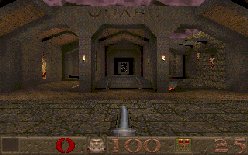
Some problems from the early stereo functions in standard
Quake has been fixed. The weapon looks perfect now.
The overall impression of the newest H3D-DOS-Quake version is very
good. The depth can be set to maximum without much eyestrain.
A very important difference between standard-stereo-Quake and H3D-Quake
is the 3D-accelerator support, which isn't available at all in the standard
version.
It might be neccessary to start h3dquake with command line option -h3d.
You have to remove SET
FX_GLIDE_SWAPINTERVAL=0 from your autoexec.bat
to get H3D-GL-Quake working. (Thanks to Matt
Barrett, Visual Clan.)
The shell commands are usually not needed. The functions are available
in the options menu.
Shell Commands for H3D-Quake
|
Function:
|
H3D_AUTO x
|
???
|
H3D_CALIBRATE x
|
x-values other than 0 call up the calibration screen
|
H3D_CSEP x (???)
|
Depth. Controls eye separation. Negative values might reverse
stereo
|
H3D_ENABLE x
|
x-values other than 0 enable stereo mode
|
H3D_PSEP x
|
Depth. Controls eye separation. Negative values might reverse
stereo
|
H3D_VGAP x
|
Position. Same function as calibration screen.
|
???
|
I wonder if there is a way to choose manually between page-flipping
and sync doubler mode.
|
Brightland H3DView
The Brightland
H3D image viewer has finally been released. The viewer supports above-below,
interlaced, parallel view and anaglyph (red/blue) stereo formats. There
are load and save functions for JPS, JPG, TGA and the new *.H3D file format.
The save function conserves the full resolution of the initial stereo pair.
The zoom-plus-filter function is really cool.
It allows to use the program in hi-res mode, like 1280x1024, and still
watch lo-res images in full-screen without pixelization effects. You can
zoom far into stereo pix "Blade-Runner-style". When it comes to image quality
this viewer is second to none. (Correct me if i'm wrong, but the other
programs I saw before had no filter.)
The full resolution of the stereo pair is used.
Example: Two 640x480 images are loaded. By viewing such a stereo pair with
the Brightland viewer at 1280x1024 no lines are lost. A standard interleaved
format stereo viewer would axe half of the resolution, since it would generate
a single interleaved 640x480 image.
To be fair it should be mentioned that programs
like NuVision 3D-Pix or VRex DepthCharge achieve this too by using full-res
page-flipping.
Other features include move, rotate, crop, parallax
control, stereo reverse.
Images are best loaded by drag and drop them
into the preview window.
What I'm missing at this point are slideshow-,
batch-conversion- and thumbnail- functions. This may be added later, but
don't count on it yet.
The viewer is suitable for H3D, VR-Joy, 60GX (sync-doubler),
CrystalEyes (sync doubler). Other windows compatible glasses, like SimulEyes/3D-fanatix
(WLC is kept intact), 3D-Max, APEC-VGA, VGA-PT, i-Art, Cyberstuff and more
are also supported, but require the usual interlace drivers. The H3D hardware
offers the best comfort here since everything works automatically.
The program is shareware and sells for $20.
Check www.brightland.com
or info@brightland.com for details.
H3D has announced a TV-version of the controller and some Stereo3D videos.
Check the movie-page.
Videos on DVD for use with the PC-version are also conceivable.
The Heaven and the Hell of H3D
In my opinion the H3D is a wonderful product and
a disappointment at the same time.
First of all the H3D has a VGA-pass-through controller
which syncs to anything (very good, but we saw that in other products before)
and in addition a built in Sync-Doubler.
This helps VGA-chipsets which doesn't support either page-flipping or interlace
modes (fantastic).
Because of this unique (in the consumer market)
feature the H3D is AFAIK the only consumer 3D-shutterglasses system which
work for 3DFX Voodoo Graphics add-on boards (Voodoo2 and Rush do support
page-flipping and will not need this).
In theory the H3D controller would be able to
run almost any Stereo3D-software imaginable. It would run almost all titles
you find on my software lists, including almost everything on the Games-Hotlist.
But H3D decided otherwise. They decided to abandon
all existing Stereo3D-software and allow the H3D controller to activate
the glasses only in case "H3D-Certified" software is started. There is
a "line pattern" shortly displayed at program startup which tells the controller
to activate the glasses. It handles the left/right orientation and stereo
mode selection (page-flipped, sync doubled or other) as well. The H3D controller
has no buttons or software tools for on/off (force3D), stereo-mode-select
or stereo-reverse.
This prevents H3D to run old interleaved, old
split screen, old page-flipped, HMD, LCD-BIOS or 3D-BIOS software, in other
words any software which existed before the H3D.
It doesn't seem to prevent other VGA-pass-through
devices to run H3D software however, as long as Sync Doubling isn't required.
H3D wants to maintain a high quality standard
for 3D software. Only new, tested, flawless, hassle free stereo-software-titles,
which are pleasing to the eyes, are allowed to run on the H3D hardware,
to secure the good reputation of the product.
H3D believes that there was some damage done
by other products in the past, which led to bad press and to resentments
in the software industry against Stereo3D.
With H3D-certified software the system will run
perfectly on ANY graphics-hardware - that's the revolution!!! It's very
easy to setup and will give the user a perfect 3D-experience from the first
minute (some -not all- of the older systems were a bit tricky here). The
H3D will be available in the shops all over the world, no more searching
the web for those rare mail-order items. They might have real strong distribution
(through Electronic Arts) and advertising - that's the second revolution!!!
And for the first time there is real hope for strong hi-class consumer
software support. The team-up of H3D with id-software and Electronic Arts
is an incredible achievement - that's the third revolution!!! The H3D glasses
are the lightest I ever saw, even lighter than wired glasses - that's the
fourth revolution. They are quite comfortable and the optical quality it
good. (Those are my words, no marketing stuff.)
So the H3D is a wonderful dream OR a nightmare,
that's just a matter of perspective.
For the real freaks and hackers and the lovers
of classic software (like Duke3D, Magic Carpet, MDK, Nascar, Hi-Octane,
Whiplash, Terminal Velocity, Descent 1+2 and more...)
among us it's a bit sad, because we were incredibly close to the PERFECT
system. And this perfect system seems to really exist! It exists in the
shape of the H3D-developer-version. This developer box has buttons and
can do anything. It's the best of both worlds. The consumer version can
do
anything too, but H3D seems to have done something to it which I would
describe as crippling.
I'm certain there will be pattern-hacks for older
software titles, just like the Quake-White-Line-Code hack. A SSDI driver
for the H3D is also conceivable.
The future of 3D looks brighter than ever now,
maybe just not as bright as I hoped for.
I'd like to thank the H3D and
the Brightland teams for their
support.
Special thanks to H3D
Entertainment Inc. for providing me with H3D Eyewear samples.
Please consult the Shutterglasses
Comparison
Chart for a complete market-overview.
|



Don't miss the rest of this 3D website!!!
Brand and product names are trademarks or registered trademarks of their
respective holders.
Most images are "borrowed" from the official manufacturer sites.
The author can not guarantee the accuracy or topicality of the information
given on this page.
Christoph Bungert, Germany
















